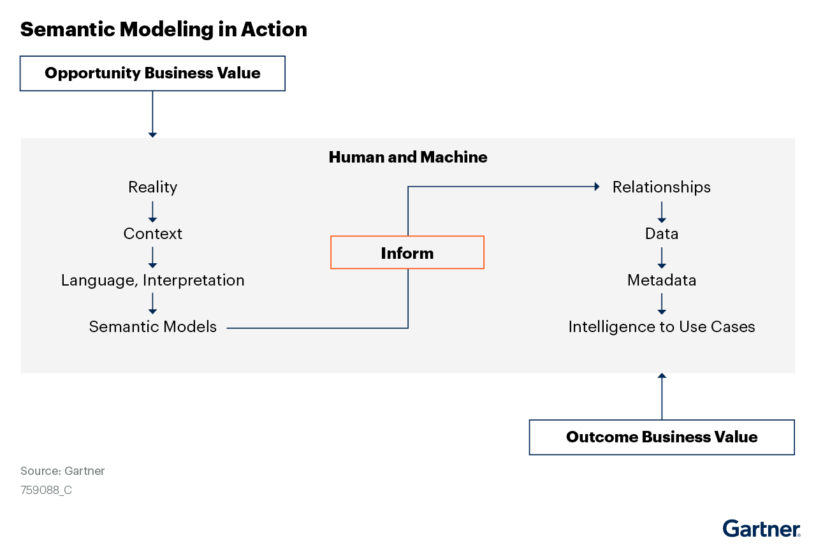One phrase that has become extremely well-known in the rapidly changing field of data analytics is “Semantic Layer.” By bridging the gap between unstructured data and valuable insights, this innovative idea revolutionizes how businesses handle their data. We will delve into the complexities of the Semantic Layer in this article, examining its benefits, current market penetration, and critical role in producing actionable insights.
Why Do We Need a Semantic Layer?
The process of turning data into insights is frequently fraught with complexity, particularly when working with sizable datasets from various sources. Serving as an abstraction layer, the semantic layer offers a common vocabulary and framework for interpreting data. It is easier for end users to interact with and extract value from the data because of this abstraction, which protects them from the complexities of underlying data models, databases, and structures.
Examples of Semantic Layer in Action:
- Business Glossary: Imagine a large enterprise with multiple departments using different terms to describe similar concepts. Marketing may refer to “customer engagement,” while Sales may use the term “client interaction.” Without a common language, collaboration and cross-departmental analysis become challenging. The Semantic Layer can act as a business glossary, providing a unified vocabulary that translates varied terminology into a standardized set of terms. This ensures that everyone within the organization speaks the same language when analyzing and interpreting data, fostering collaboration and improving overall data literacy. Example: A marketing report might use the term “customer engagement,” and the Semantic Layer ensures that this is seamlessly translated into “client interaction” for the sales team, creating a cohesive understanding of customer interactions across departments.
- Cross-Platform Data Integration: Consider a scenario where a retail company collects data from online sales, in-store transactions, and customer feedback surveys. Each source employs different data structures and formats, making it challenging to derive comprehensive insights. The Semantic Layer acts as a middleware that harmonizes these diverse data sources, providing a unified view. This allows analysts to seamlessly combine and analyze data from various platforms without delving into the intricacies of each data source. Example: The retail company can use the Semantic Layer to merge online sales data, in-store transactions, and customer feedback into a unified report, providing a holistic view of customer behavior across all touchpoints.
- Dynamic Data Model Evolution: In a dynamic business environment, data models often need to evolve to accommodate changing business needs. Without a Semantic Layer, these changes can be disruptive and time-consuming, requiring adjustments to reporting tools and queries. With a Semantic Layer in place, the data model can evolve seamlessly behind the scenes. This ensures that users continue to interact with the data without interruption, even as underlying structures change. Example: A financial institution introduces a new product, requiring adjustments to the data model. The Semantic Layer facilitates a smooth transition, allowing analysts to continue querying and reporting on existing data while the system dynamically adapts to the changes in the background.
Advantages of the Semantic Layer:
- Data Consistency and Accuracy: The Semantic Layer ensures that data is represented consistently across the organization. By providing a standardized view of the data, it reduces the likelihood of discrepancies and errors in analysis.
- Enhanced Accessibility: With the Semantic Layer in place, users can access and interpret data without needing an in-depth understanding of underlying data structures. This democratization of data empowers users across various departments and skill levels to harness the power of analytics.
- Improved Efficiency: Eliminating the need to navigate complex databases and structures, the Semantic Layer accelerates the analytics process. This results in quicker decision-making and a more agile response to changing business needs.
- Adaptability to Change: As businesses evolve, so do their data requirements. The Semantic Layer provides a flexible framework that can adapt to changes in data sources, structures, and business rules, ensuring that the analytics ecosystem remains resilient and future-proof.
Generating Insights with the Semantic Layer:
- Query Optimization: The Semantic Layer optimizes queries, translating user requests into efficient queries that the underlying data sources can process. This optimization not only speeds up the analytics process but also ensures that queries are executed accurately.
- Advanced Analytics: By abstracting complex data structures, the Semantic Layer enables organizations to leverage advanced analytics techniques such as machine learning and predictive modeling. This opens the door to deeper insights and more accurate forecasting.
- Self-Service Analytics: With a Semantic Layer in place, organizations can embrace self-service analytics, empowering users to explore and analyze data on their own terms. This shift reduces the burden on IT teams and fosters a culture of data-driven decision-making across the organization.
Current Market Penetration:
Semantic Layers are becoming more and more popular in a variety of industries. Giving users a streamlined, cohesive view of their data is crucial, and this is recognized by contemporary analytics platforms and business intelligence tools. Increasingly, businesses are using Semantic Layers in their analytics strategies to improve data-driven decision-making in accordance with current market trends.
The Semantic Layer becomes an essential part of the analytics toolkit in the data-driven era, providing a standardized and streamlined means of interacting with complex datasets. Because of its capacity to improve data accessibility, guarantee consistency, and support advanced analytics, it is positioned as a crucial enabler for businesses looking to extract meaningful insights from their data. Businesses are positioned to realize the full potential of their data as the use of Semantic Layers grows, spurring innovation and maintaining competitiveness in an ever-changing market.
Happy Learning and Adapting !




Leave a Reply